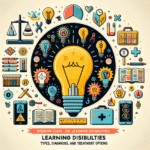
Redefining Exam Success: Innovative Strategies for Students with Learning Disabilities
Introduction
In today’s fast-paced educational landscape, success is often measured by grades and test scores. However, for students with learning disabilities, this traditional approach can feel like an insurmountable hurdle. As educators, parents, and policymakers strive to create inclusive environments, it is critical to reassess how we define exam success. Redefining Exam Success: Innovative Strategies for Students with Learning Disabilities is not just a catchphrase; it signifies a transformative shift toward empowering students by implementing unique methods tailored to their diverse needs. Through understanding, creativity, and innovative thinking, we can support students in navigating their educational journeys with resilience and confidence.
Understanding Learning Disabilities
Before delving into innovative strategies, it’s essential to understand what learning disabilities entail. These are neurological conditions that affect the brain’s ability to receive and process information. Common types include dyslexia (reading difficulties), dyscalculia (mathematics-related difficulties), and ADHD (Attention Deficit Hyperactivity Disorder). Each type presents unique challenges, particularly concerning academic assessments, making it vital to rethink how examinations can be structured to accommodate all learners.
The Importance of Redefining Success
To redefine success in academic settings, we must emphasize strengths rather than weaknesses. Traditional examination formats often fail to represent the true capabilities of students with learning disabilities. By focusing on innovative strategies that celebrate learning diversity, we can create a more inclusive educational environment that recognizes and nurtures different forms of intelligence.
Innovative Strategies for Redefining Exam Success
1. Alternative Assessment Methods
One of the foremost methodologies in Redefining Exam Success: Innovative Strategies for Students with Learning Disabilities is to explore alternative assessment formats. Traditional tests, often reliant on memorization and standardized formats, may not effectively showcase a student’s knowledge or understanding.
Case Study: Project-Based Learning
A school district in California adopted project-based learning (PBL) as an alternative to standardized testing. Students worked on projects that integrated multiple subjects, allowing them to demonstrate their knowledge through creativity and real-world applications.
Analysis: This case illustrates how PBL fosters deeper comprehension and engagement, reducing anxiety and making assessments feel more relevant to students’ lives.
| Study Type | Traditional Assessment | Project-Based Assessment |
|---|---|---|
| Stress Level | High | Moderate |
| Engagement | Low | High |
| Knowledge Demonstration | Surface Level | In-Depth Understanding |
2. Utilizing Technology
The integration of technology in education has opened new avenues for students with learning disabilities. Tools like text-to-speech software, interactive learning platforms, and video recording apps can greatly assist in assessment environments.
Case Study: Use of Assistive Technology
A middle school in New York implemented iPad programs that included apps designed for students with dyslexia. These students were able to utilize features like audio support for reading comprehension tests.
Analysis: The use of assistive technology allowed students to demonstrate their understanding without being hindered by decoding challenges, thus redefining their exam success.
3. Flexible Timing and Conditions
Allowing flexible timing and conditions during exams can significantly benefit students with learning disabilities. Extended time and a distraction-free environment afford students the opportunity to exhibit their true abilities without the pressure of traditional time constraints.
Case Study: Weekend Testing Program
A teaching college in Texas offered weekend testing programs for students who struggled significantly with in-class exam conditions. This initiative provided students with additional time and a conducive environment for completing their assessments.
Analysis: By facilitating a supportive testing atmosphere, this program not only reduced anxiety but also led to improved performance among students with disabilities.
4. Collaborative Learning Opportunities
Promoting collaborative learning can lead to significant advancements in student engagement and knowledge retention. Group projects enable students to leverage their strengths and provide mutual support.
Case Study: Peer Tutoring System
A high school in Illinois developed a peer tutoring system pairing students with learning disabilities with their peers. This system encouraged collaboration and allowed students to learn from each other’s strengths.
Analysis: Peer tutoring not only built confidence among students with learning disabilities but also fostered a sense of belonging, which is crucial for emotional well-being.
5. Focus on Constructive Feedback
Rather than solely assessing what students get wrong, educators should place a higher value on constructive feedback. This strategy encourages growth and helps students focus on the process of learning rather than just the results.
Case Study: Feedback-Focused Grading
A university in Washington shifted from traditional grading to a feedback-focused grading system. In this model, students received comments on their assignments that highlighted strengths and offered specific guidance for improvement.
Analysis: This approach made students feel more invested in their learning journey, proving that success can be a continuum rather than a fixed point.
Creating an Inclusive Environment for Exam Success
Teacher Training and Awareness
For any strategy to be effective, educators must receive training that equips them with the ability to recognize and cater to the diverse needs of students. This awareness fosters a supportive classroom environment where all students can thrive.
Parent and Community Involvement
Engaging parents and community members in discussions about learning disabilities and exam success can build a support network. Hosting workshops for parents on how to advocate for their children can make a significant difference in home and school collaborations.
Conclusion: A New Era of Exam Success
In conclusion, the journey toward Redefining Exam Success: Innovative Strategies for Students with Learning Disabilities is both a challenge and an opportunity. By implementing alternative assessments, leveraging technology, allowing flexible conditions, promoting collaboration, and focusing on constructive feedback, we can create a more inclusive educational landscape. Both educators and students are capable of tremendous growth when the emphasis shifts from traditional metrics of success to innovative strategies that celebrate learning diversity.
Let’s empower every student to harness their unique strengths, ensuring that exam success is tangible and attainable for all.
FAQs
1. What are some common types of learning disabilities?
Common types include dyslexia, dyscalculia, ADHD, and nonverbal learning disabilities.
2. How can teachers support students with learning disabilities during exams?
Teachers can provide alternative assessments, offer extended time, and create a distraction-free environment.
3. What role does technology play in supporting students with learning disabilities?
Technology can offer assistive tools, such as text-to-speech software and interactive learning apps, to help students express their understanding.
4. How can parents be involved in supporting their children with learning disabilities?
Parents can advocate for their children by communicating with teachers, attending workshops, and creating a supportive home environment.
5. What innovative strategies can help redefine exam success?
Strategies include project-based learning, flexible timing, collaborative learning, and feedback-focused grading.
With these strategies in place, we not only redefine exam success for students with learning disabilities but also foster a future where every learner can thrive. Let’s celebrate diversity in learning and embrace the myriad ways through which success can be achieved!









